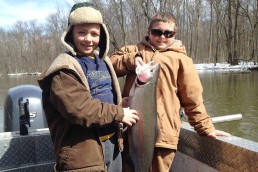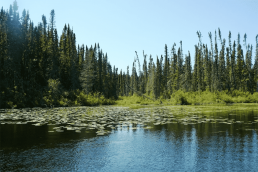St. Joseph River, Area Lakes Get More ‘Eyes
The future of Michiana walleye fishing got a big boost last year with multiple stockings in the St. Joseph River and inland lakes.
Some 10,500 walleyes measuring 6 to 8 inches were planted in October into the St. Joe between the Twin Branch and Elkhart dams. The Indiana DNR and the Michiana Walleye Association stock the river in alternate years.
The nice-size fish were purchased from Gollon Bait and Fish Farm, Dodgeville, Wis. They should reach legal size (16 inches) in about three years.
Out of the total amount of those fish, the Michiana Walleye Association purchased 2,500, as they have done for several years. The bulk of the rest were paid for through funds provided by I&M Electric, as part of its agreement with the Indiana DNR.
Walleyes that size don’t come cheap, but are worth it. Their survival is much better than stockings with smaller fish, especially in this climate. The walleye club pays for its share with proceeds it earns at its annual outdoors show and other fundraisers held throughout the year.
The St. Joseph River has become one of the state’s best success stories for walleye stocking and the local club deserves a lot of credit for it.
This year’s fishing was a little off, as it was for other species in Michiana waters, but last year produced a lot of nice keeper-size walleyes. The recent increase in the size limit from 15 to 16 inches should provide even better fishing for quality walleyes in the years to come.
In addition to the river, several lake groups made private stockings with the DNR’s blessing this fall. Those include Simonton Lake in Elkhart County (1,024), Little Turkey (500) and Lake of the Woods (800) in LaGrange County, Big Turkey (1,775), Lake George (2,500) and Golden Lake (1,500) in Steuben County and Fish Lake (530) in LaPorte County.
In addition to fall stockings, smaller walleyes (1.5 inches) were planted last spring at Lake of the Woods (24,000) and Lake Maxinkuckee (199,000) in Marshall County.
District Fisheries Biologist Tom Bacula said his crew surveyed both of those lakes and Bass Lake this fall to determine stocking success from recent years.
“Lake of the Woods near Bremen continues to be a top walleye location,” he said. “We collected walleyes up to 18.6 inches, but our catch of 16-plus fish was above average. Also, the survival of walleyes stocked last spring was well above average, too.”
Lake Maxinkuckee continues to baffle biologists. Catch rates remain poor despite changes in stocking strategies. The state has stocked it for decades.
“Anglers who catch them often get quality fish, but they have to work for them,” Bacula said.
Based on fishing reports we get, Maxinkuckee produces its biggest walleyes in the spring and at night.
Bacula said Bass Lake located southeast of Knox, Ind. offered a mixed bag of results in this year’s survey. The overall assessment was down, but the number of walleyes 14 inches or longer was above average.
“Bass Lake isn’t known for trophy walleyes that other lakes produce, but there are higher catch rates,” he added. “Quite a few get caught through the ice—if you can find them.”
Louie Stout is a Hall of Fame journalist and longtime “Bassmaster” Senior Writer who has covered Indiana and Michigan outdoors for more than 40 years. He’s co-authored three books with Kevin VanDam and is the outdoors columnist for the South Bend Tribune.
MWO
SHARE THIS POST
Did you enjoy this post?
You can be among the first to get the latest info on where to go, what to use and how to use it!
Louie Stout
Louie Stout is a Hall of Fame journalist and longtime Bassmaster Senior Writer who has covered Indiana and Michigan outdoors for more than 40 years. He’s co-authored three books with Kevin VanDam and is the outdoors columnist for the South Bend Tribune.



